
Irregular satellite
Encyclopedia
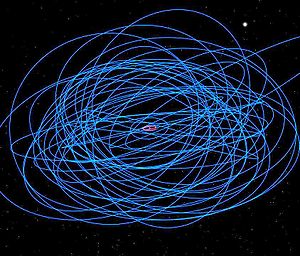
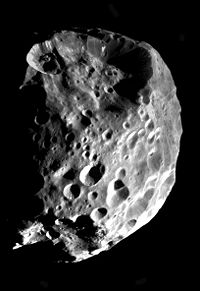
Astronomy
Astronomy is a natural science that deals with the study of celestial objects and phenomena that originate outside the atmosphere of Earth...
, an irregular moon is a natural satellite
Natural satellite
A natural satellite or moon is a celestial body that orbits a planet or smaller body, which is called its primary. The two terms are used synonymously for non-artificial satellites of planets, of dwarf planets, and of minor planets....
following a distant, inclined, and often eccentric
Orbital eccentricity
The orbital eccentricity of an astronomical body is the amount by which its orbit deviates from a perfect circle, where 0 is perfectly circular, and 1.0 is a parabola, and no longer a closed orbit...
and retrograde orbit. They are believed to have been captured by their parent planet, unlike regular satellites, which form in situ
In situ
In situ is a Latin phrase which translated literally as 'In position'. It is used in many different contexts.-Aerospace:In the aerospace industry, equipment on board aircraft must be tested in situ, or in place, to confirm everything functions properly as a system. Individually, each piece may...
.
Ninety-three irregular satellites have been discovered since 1997, orbiting all four of the giant planets (Jupiter
Jupiter
Jupiter is the fifth planet from the Sun and the largest planet within the Solar System. It is a gas giant with mass one-thousandth that of the Sun but is two and a half times the mass of all the other planets in our Solar System combined. Jupiter is classified as a gas giant along with Saturn,...
, Saturn
Saturn
Saturn is the sixth planet from the Sun and the second largest planet in the Solar System, after Jupiter. Saturn is named after the Roman god Saturn, equated to the Greek Cronus , the Babylonian Ninurta and the Hindu Shani. Saturn's astronomical symbol represents the Roman god's sickle.Saturn,...
, Uranus
Uranus
Uranus is the seventh planet from the Sun. It has the third-largest planetary radius and fourth-largest planetary mass in the Solar System. It is named after the ancient Greek deity of the sky Uranus , the father of Cronus and grandfather of Zeus...
and Neptune
Neptune
Neptune is the eighth and farthest planet from the Sun in the Solar System. Named for the Roman god of the sea, it is the fourth-largest planet by diameter and the third largest by mass. Neptune is 17 times the mass of Earth and is slightly more massive than its near-twin Uranus, which is 15 times...
). Before 1997, only ten were known, including Phoebe
Phoebe (moon)
Phoebe is an irregular satellite of Saturn. It was discovered by William Henry Pickering on 17 March 1899 from photographic plates that had been taken starting on 16 August 1898 at the Boyden Observatory near Arequipa, Peru, by DeLisle Stewart...
, the largest irregular satellite of Saturn, and Himalia
Himalia (moon)
Himalia is the largest irregular satellite of Jupiter, the sixth largest overall in size, and the fifth largest in mass. It was discovered by Charles Dillon Perrine at the Lick Observatory on 3 December 1904 and is named after the nymph Himalia, who bore three sons of Zeus .- Discovery...
, the largest irregular satellite of Jupiter. Sycorax
Sycorax (moon)
Sycorax is the largest retrograde irregular satellite of Uranus. Sycorax was discovered on 6 September 1997 by Brett J. Gladman, Philip D. Nicholson, Joseph A. Burns, and John J...
, the largest irregular moon of Uranus, was discovered in 1997.
It is currently thought that the irregular satellites were captured from heliocentric orbit
Heliocentric orbit
A heliocentric orbit is an orbit around the Sun. All planets, comets, and asteroids in our Solar System are in such orbits, as are many artificial probes and pieces of debris. The moons of planets in the Solar System, by contrast, are not in heliocentric orbits as they orbit their respective planet...
s near their current locations, shortly after the formation of their parent planet. An alternative theory, that they originated further out in the Kuiper belt
Kuiper belt
The Kuiper belt , sometimes called the Edgeworth–Kuiper belt, is a region of the Solar System beyond the planets extending from the orbit of Neptune to approximately 50 AU from the Sun. It is similar to the asteroid belt, although it is far larger—20 times as wide and 20 to 200 times as massive...
, is not supported by current observations.
Definition
| Planet | rH (Gm Gigametre A gigametre is a unit of length in the metric system, equal to one billion meters, the SI base unit of length, hence to 1,000,000 km or approximately 621,370 miles.... ) |
|---|---|
| Jupiter | 51 |
| Saturn | 69 |
| Uranus | 73 |
| Neptune | 116 |
There is no widely accepted precise definition of an irregular satellite. Informally, satellites are considered irregular if they are far enough from the planet that the precession of their orbital plane
Orbital plane
Orbital plane may refer to:*Orbital plane *In anatomy, it refers to a specific area of the maxilla...
is primarily controlled by the Sun.
In practice, the satellite's semi-major axis
Semi-major axis
The major axis of an ellipse is its longest diameter, a line that runs through the centre and both foci, its ends being at the widest points of the shape...
is compared with the planet's Hill sphere
Hill sphere
An astronomical body's Hill sphere is the region in which it dominates the attraction of satellites. To be retained by a planet, a moon must have an orbit that lies within the planet's Hill sphere. That moon would, in turn, have a Hill sphere of its own...
(that is, the sphere of its gravitational influence)
 . Irregular satellites have semi-major axes greater than 0.05
. Irregular satellites have semi-major axes greater than 0.05  with apoapses extending as far as to 0.65
with apoapses extending as far as to 0.65  . The radius of the Hill sphere is given in the adjacent table.
. The radius of the Hill sphere is given in the adjacent table.Current distribution
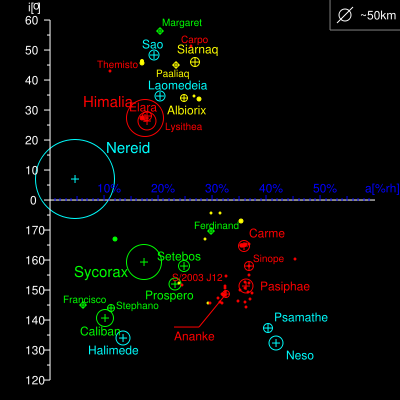
Retrograde and direct motion
Apparent retrograde motion is the motion of a planetary body in a direction opposite to that of other bodies within its system as observed from a particular vantage point...
s are far more common (83%) than prograde orbits. No satellites are known with orbital inclinations higher than 55° (or smaller than 130° for retrograde satellites). In addition, some groupings can be identified, in which one large satellite shares a similar orbit with a few smaller ones.
Given their distance from the planet, the orbits of the outer satellites are highly perturbed by the Sun and their orbital elements change widely over short intervals. The semi-major axis of Pasiphae
Pasiphaë (moon)
Pasiphaë is a retrograde irregular satellite of Jupiter. It was discovered in 1908 by Philibert Jacques Melotte and later named after the mythological Pasiphaë, wife of Minos and mother of the Minotaur from Greek legend....
, for example, changes as much as 1.5 Gm in two years (single orbit), the inclination around 10°, and the eccentricity as much as 0.4 in 24 years (twice Jupiter’s orbit period).
Consequently, mean orbital elements (averaged over time) are used to identify the groupings rather than osculating elements
Osculating orbit
In astronomy, and in particular in astrodynamics, the osculating orbit of an object in space is the gravitational Kepler orbit In astronomy, and in particular in astrodynamics, the osculating orbit of an object in space (at a given moment of time) is the gravitational Kepler orbit In astronomy,...
at the given date. (Similarly, the proper orbital elements
Proper orbital elements
The proper orbital elements of an orbit are constants of motion of an object in space that remain practically unchanged over an astronomically long timescale...
are used to determine the families of asteroids
Asteroid family
An asteroid family is a population of asteroids that share similar proper orbital elements, such as semimajor axis, eccentricity, and orbital inclination. The members of the families are thought to be fragments of past asteroid collisions...
.)
Origin
Irregular satellites are believed to have been captured from heliocentric orbits. (Indeed, it appears that the irregular moons of the gas giants, the JovianTrojan asteroid
The Jupiter Trojans, commonly called Trojans or Trojan asteroids, are a large group of objects that share the orbit of the planet Jupiter around the Sun. Relative to Jupiter, each Trojan librates around one of the planet's two Lagrangian points of stability, and , that respectively lie 60° ahead...
and Neptunian trojans
Neptune Trojan
Neptune trojans are Kuiper belt object-like bodies in solar orbit that have the same orbital period as Neptune and follow roughly the same orbital path...
, and grey Kuiper belt objects have a similar origin.) For this to occur, one of three things needs to have happened:
- energy dissipation (e.g. in interaction with the primordial gas cloud)
- a substantial (40%) extension of the planet's Hill sphereHill sphereAn astronomical body's Hill sphere is the region in which it dominates the attraction of satellites. To be retained by a planet, a moon must have an orbit that lies within the planet's Hill sphere. That moon would, in turn, have a Hill sphere of its own...
in a brief period of time (thousands of years) - a transfer of energy in a three-body interaction. This could involve:
- a collision (or close encounter) of an incoming body and a satellite, resulting in the incoming body losing energy and being captured.
- a close encounter between an incoming binary object and the planet (or possibly an existing moon), resulting in one component of the binary being captured. Such a route has been suggested as most likely for TritonTriton (moon)Triton is the largest moon of the planet Neptune, discovered on October 10, 1846, by English astronomer William Lassell. It is the only large moon in the Solar System with a retrograde orbit, which is an orbit in the opposite direction to its planet's rotation. At 2,700 km in diameter, it is...
.
After the capture, some of the satellites could break up leading to groupings of smaller moons following similar orbits. Resonances
Orbital resonance
In celestial mechanics, an orbital resonance occurs when two orbiting bodies exert a regular, periodic gravitational influence on each other, usually due to their orbital periods being related by a ratio of two small integers. Orbital resonances greatly enhance the mutual gravitational influence of...
could further modify the orbits making these groupings less recognizable.
Long-term stability
Remarkably, the current orbits prove stable in numerical simulations, in spite of substantial perturbations near the apocenter.The cause of this stability in a number of irregulars is the fact that they orbit with a secular
Secular resonance
A secular resonance is a type of orbital resonance.Secular resonances occur when the precession of two orbits is synchronised . A small body in secular resonance with a much larger one will precess at the same rate as the large body...
or Kozai resonance
Kozai mechanism
In celestial mechanics, the Kozai mechanism, or the Lidov-Kozai mechanism, causes a periodic exchange between the inclination and eccentricity of an orbit...
.
In addition, simulations indicate the following conclusions:
- Orbits with inclinations higher than 50° (or 130° for retrograde orbits) are very unstable: their eccentricity increases quickly resulting in the satellite being lost
- Retrograde orbits are more stable than prograde (stable retrograde orbits can be found further from the planet)
Increasing eccentricity results in smaller pericenters and large apocenters. The satellites enter the zone of the regular (larger) moons and are lost or ejected via collision and close encounters. Alternatively, the increasing perturbations by the Sun at the growing apocenters push them beyond the Hill sphere.
Retrograde satellites can be found further from the planet than prograde ones. Detailed numerical integrations have shown this asymmetry. The limits are a complicated function of the inclination and eccentricity, but in general, prograde orbits with semi-major axes up to 0.47 rH (Hill sphere radius) can be stable, while for retrograde orbits stability can extend out to 0.67 rH.
The boundary for the semimajor axis is surprisingly sharp for the prograde satellites. A satellite on a prograde, circular orbit (inclination=0°) placed at 0.5 rH would leave Jupiter in as little as forty years. The effect can be explained by so called evection resonance. The apocenter of the satellite, where the planet’s grip on the moon is at its weakest, gets locked in resonance with the position of the Sun. The effects of the perturbation accumulate at each passage pushing the satellite even further outwards.
The asymmetry between the prograde and retrograde satellites can be explained very intuitively by the Coriolis acceleration in the frame rotating with the planet. For the prograde satellites the acceleration points outward and for the retrograde it points inward, stabilising the satellite.
Size
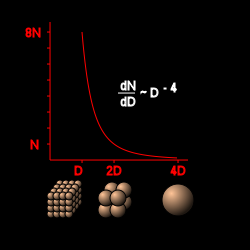
Typically, the relation expressing the number
 of objects of the diameter smaller or equal to
of objects of the diameter smaller or equal to  is approximated by a power law
is approximated by a power lawPower law
A power law is a special kind of mathematical relationship between two quantities. When the frequency of an event varies as a power of some attribute of that event , the frequency is said to follow a power law. For instance, the number of cities having a certain population size is found to vary...
:
-
 with q defining the slope.
with q defining the slope.
A shallow power law (q~2) is observed for sizes 10 to 100 km† but steeper (q~3.5) for objects smaller than 10 km‡ .
For comparison, the distribution of Kuiper Belt
Kuiper belt
The Kuiper belt , sometimes called the Edgeworth–Kuiper belt, is a region of the Solar System beyond the planets extending from the orbit of Neptune to approximately 50 AU from the Sun. It is similar to the asteroid belt, although it is far larger—20 times as wide and 20 to 200 times as massive...
objects is much steeper (q~4), i.e. for one object of 1000 km there are a thousand objects with a diameter of 100 km. The size distribution provides insights into the possible origin (capture, collision/break-up or accretion).
†For every object of 100 km, ten objects of 10 km can be found.
‡For one object of 10 km, some 140 objects of 1 km can be found.
Colours
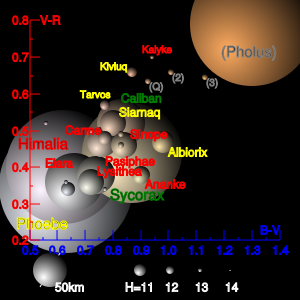
Color index
In astronomy, the color index is a simple numerical expression that determines the color of an object, which in the case of a star gives its temperature...
: simple measures of differences of the apparent magnitude
Apparent magnitude
The apparent magnitude of a celestial body is a measure of its brightness as seen by an observer on Earth, adjusted to the value it would have in the absence of the atmosphere...
of an object through blue
Blue
Blue is a colour, the perception of which is evoked by light having a spectrum dominated by energy with a wavelength of roughly 440–490 nm. It is considered one of the additive primary colours. On the HSV Colour Wheel, the complement of blue is yellow; that is, a colour corresponding to an equal...
(B), visible i.e. green-yellow (V), and red
Red
Red is any of a number of similar colors evoked by light consisting predominantly of the longest wavelengths of light discernible by the human eye, in the wavelength range of roughly 630–740 nm. Longer wavelengths than this are called infrared , and cannot be seen by the naked eye...
(R) filter
Filter (optics)
Optical filters are devices which selectively transmit light of different wavelengths, usually implemented as plane glass or plastic devices in the optical path which are either dyed in the mass or have interference coatings....
s. The observed colours of the irregular satellites vary from neutral (greyish) to reddish (but not as red as the colours of some Kuiper Belt objects).
| albedo Albedo Albedo , or reflection coefficient, is the diffuse reflectivity or reflecting power of a surface. It is defined as the ratio of reflected radiation from the surface to incident radiation upon it... |
neutral | reddish | red |
|---|---|---|---|
| low | C C-type asteroid C-type asteroids are carbonaceous asteroids. They are the most common variety, forming around 75% of known asteroids, and an even higher percentage in the outer part of the asteroid belt beyond 2.7 AU, which is dominated by this asteroid type... 3-8% |
P P-type asteroid P-type asteroids have low albedo and a featureless reddish electromagnetic spectrum. It has been suggested that they have a composition of organic rich silicates, carbon and anhydrous silicates, possibly with water ice in their interior... 2-6% |
D D-type asteroid D-type asteroids have a very low albedo and a featureless reddish electromagnetic spectrum. It has been suggested that they have a composition of organic rich silicates, carbon and anhydrous silicates, possibly with water ice in their interiors... 2-5% |
| medium | M M-type asteroid M-type asteroids are asteroids of partially known composition; they are moderately bright . Some, but not all, are made of nickel-iron, either pure or mixed with small amounts of stone. These are thought to be pieces of the metallic core of differentiated asteroids that were fragmented by impacts,... 10-18% |
A A-type asteroid A-type asteroids are relatively uncommon inner-belt asteroids that have a strong, broad 1 µm olivine feature and a very reddish spectrum shortwards of 0.7 µm. They are thought to come from the completely differentiated mantle of an asteroid.... 13-35% |
|
| high | E E-type asteroid E-type asteroids are asteroids thought to have enstatite achondrite surfaces. They form a large proportion of asteroids inward of the main belt known as Hungaria asteroids, but rapidly become very rare as the main belt proper is entered. There are, however, some that are quite far from the inner... 25-60% |
Each planet's system displays slightly different characteristics. Jupiter's irregulars are grey to slightly red, consistent with C
C-type asteroid
C-type asteroids are carbonaceous asteroids. They are the most common variety, forming around 75% of known asteroids, and an even higher percentage in the outer part of the asteroid belt beyond 2.7 AU, which is dominated by this asteroid type...
, P
P-type asteroid
P-type asteroids have low albedo and a featureless reddish electromagnetic spectrum. It has been suggested that they have a composition of organic rich silicates, carbon and anhydrous silicates, possibly with water ice in their interior...
and D-type asteroid
D-type asteroid
D-type asteroids have a very low albedo and a featureless reddish electromagnetic spectrum. It has been suggested that they have a composition of organic rich silicates, carbon and anhydrous silicates, possibly with water ice in their interiors...
s. Some groups of satellites are observed to display similar colours (see later sections). Saturn's irregulars are slightly redder than those of Jupiter.
The large Uranian irregular satellites (Sycorax
Sycorax (moon)
Sycorax is the largest retrograde irregular satellite of Uranus. Sycorax was discovered on 6 September 1997 by Brett J. Gladman, Philip D. Nicholson, Joseph A. Burns, and John J...
and Caliban
Caliban (moon)
Caliban is the second largest retrograde irregular moon of Uranus. It was discovered on 6 September 1997 by Brett J. Gladman, Philip D. Nicholson, Joseph A. Burns, and John J...
) are found light-red while smaller Prospero
Prospero (moon)
Prospero is a relatively small retrograde irregular satellite of Uranus discovered on 18 July 1999 by the astrophysicist Matthew Holman and his team, and given the provisional designation S/1999 U 3...
and Setebos
Setebos (moon)
Setebos is one of the outermost retrograde irregular satellites of Uranus. It was discovered on 18 July 1999 by John J. Kavelaars et al. and provisionally designated S/1999 U 1....
are grey as are Neptunian sateliites Nereid and Halimede.
Spectra
With the current resolution, the visible and near-infrared spectra of most satellites appear featureless. So far, water ice has been inferred on Phoebe and Nereid and features attributed to aqueous alteration were found on Himalia.Rotation
Regular satellites are usually tidally lockedTidal locking
Tidal locking occurs when the gravitational gradient makes one side of an astronomical body always face another; for example, the same side of the Earth's Moon always faces the Earth. A tidally locked body takes just as long to rotate around its own axis as it does to revolve around its partner...
(that is, their orbit is synchronous
Synchronous orbit
A synchronous orbit is an orbit in which an orbiting body has a period equal to the average rotational period of the body being orbited , and in the same direction of rotation as that body.-Properties:...
with their rotation so that they only show one face toward their parent planet). In contrast, tidal forces on the irregular satellites are negligible given their distance from the planet, and rotation periods in the range of only ten hours have been measured for the biggest moons Himalia
Himalia (moon)
Himalia is the largest irregular satellite of Jupiter, the sixth largest overall in size, and the fifth largest in mass. It was discovered by Charles Dillon Perrine at the Lick Observatory on 3 December 1904 and is named after the nymph Himalia, who bore three sons of Zeus .- Discovery...
, Phoebe
Phoebe (moon)
Phoebe is an irregular satellite of Saturn. It was discovered by William Henry Pickering on 17 March 1899 from photographic plates that had been taken starting on 16 August 1898 at the Boyden Observatory near Arequipa, Peru, by DeLisle Stewart...
and Nereid
Nereid (moon)
Nereid , also known as Neptune II, is the third-largest moon of Neptune. It has a highly eccentric orbit. Nereid was discovered by Gerard Kuiper in 1949 and was the second moon of Neptune to be discovered.- Discovery and naming :...
(to compare with their orbital periods of hundreds of days). Such rotation rates are in the same range that is typical for asteroid
Asteroid
Asteroids are a class of small Solar System bodies in orbit around the Sun. They have also been called planetoids, especially the larger ones...
s.
Families with a common origin
Some irregular satellites appear to orbit in 'groups', in which several satellites share similar orbits. The leading theory is that these objects constitute collisional familiesCollisional family
In astronomy, a collisional family is a group of objects that are thought to have a common origin in an impact . They have similar compositions, and most share similar orbital elements....
, parts of a larger body that broke up.
Dynamic groupings
Simple collision models can be used to estimate the possible dispersion of the orbital parameters given a velocity impulse δV. Applying these models to the known orbital parameters makes possible to estimate the δV necessary to create the observed dispersion. It is believed that δV of tens of meters per seconds (5–50 m/s) could result from a break-up. Dynamical groupings of irregular satellites can be identified using these criteria and the likelihood of the common origin from a break-up evaluated.When the dispersion of the orbits is too wide (i.e. it would require δV in the order of hundreds of m/s)
- either more than one collision must be assumed, i.e. the cluster should be further subdivided into groups
- or significant post-collision changes, for example resulting from resonances, must be postulated.
Colour groupings
When the colours and spectra of the satellites are known, the homogeneity of these data for all the members of a given grouping is a substantial argument for a common origin. However, lack of precision in the available data often makes it difficult to draw statistically significant conclusions. In addition, the observed colours are not necessarily representative of the bulk composition of the satellite.Irregular satellites of Jupiter
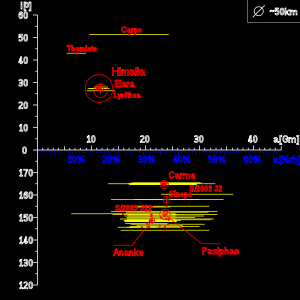
- ProgradeProgradePrograde can refer to:*Prograde or direct motion, in astronomy, a type of motion of astronomical bodies* Prograde metamorphism, in geology, describes mineral changes in rocks under increasing pressure and/or temperature conditions...
satellites- The Himalia groupHimalia groupThe Himalia group is a group of prograde irregular satellites of Jupiter that follow similar orbits to Himalia and are thought to have a common origin.The known members of the group are :* Leda...
shares an average inclination of 28°. They are confined dynamically (δV ≈ 150 m/s). They are homogenous at visible wavelengths (having neutral colours similar to those of C-type asteroidC-type asteroidC-type asteroids are carbonaceous asteroids. They are the most common variety, forming around 75% of known asteroids, and an even higher percentage in the outer part of the asteroid belt beyond 2.7 AU, which is dominated by this asteroid type...
s) and at near infraredInfraredInfrared light is electromagnetic radiation with a wavelength longer than that of visible light, measured from the nominal edge of visible red light at 0.74 micrometres , and extending conventionally to 300 µm...
wavelengths - ThemistoThemisto (moon)Themisto , also known as ', is a small prograde irregular satellite of Jupiter. It was discovered in 1975, lost, and then rediscovered in 2000.- Discovery and naming :...
is so far believed to be isolated. - CarpoCarpo (moon)Carpo , also ', is a natural satellite of Jupiter. It was discovered by a team of astronomers from the University of Hawaii led by Scott S...
is so far believed to be isolated.
- The Himalia group
- RetrogradeRetrograde-Retrograde:* Retrograde motion, in astronomy, describes retrograde motions of celestial bodies relative to a gravitationally central object* Apparent retrograde motion, in astronomy, is the apparent motion of planets as observed from a particular vantage point...
satellites- The Carme groupCarme groupThe Carme group is a group of retrograde irregular satellites of Jupiter that follow similar orbits to Carme and are thought to have a common origin....
shares an average inclination of 165°. It is dynamically tight (5 < δV < 50 m/s). It is very homogenous in colour, each member displaying light red colouring consistent with a D-type asteroidD-type asteroidD-type asteroids have a very low albedo and a featureless reddish electromagnetic spectrum. It has been suggested that they have a composition of organic rich silicates, carbon and anhydrous silicates, possibly with water ice in their interiors...
progenitor. - The Ananke groupAnanke groupThe Ananke group is a group of retrograde irregular satellites of Jupiter that follow similar orbits to Ananke and are thought to have a common origin....
shares an average inclination of 148°. It shows little dispersion of orbital parameters (15 < δV < 80 m/s). AnankeAnanke (moon)Ananke is a retrograde irregular satellite of Jupiter. It was discovered by Seth Barnes Nicholson at Mount Wilson Observatory in 1951 and is named after the mythological Ananke, the personification of Necessity, and the mother of the Moirae by Zeus...
itself appears light red but the other group members are grey. - The Pasiphae groupPasiphaë groupThe Pasiphaë group is a group of retrograde irregular satellites of Jupiter that follow similar orbits to Pasiphaë and are thought to have a common origin....
is very dispersed. PasiphaePasiphaë (moon)Pasiphaë is a retrograde irregular satellite of Jupiter. It was discovered in 1908 by Philibert Jacques Melotte and later named after the mythological Pasiphaë, wife of Minos and mother of the Minotaur from Greek legend....
itself appears to be grey while other members (CallirrhoeCallirrhoe (moon)Callirrhoe , also known as ' , is one of Jupiter's outermost named natural satellites. It is an irregular moon that orbits in a retrograde direction. Callirrhoe was imaged by Spacewatch at Kitt Peak National Observatory from October 6 through November 4, 1999, and originally designated as asteroid...
, MegacliteMegaclite (moon)Megaclite , also known as ', is a natural satellite of Jupiter. It was discovered by a team of astronomers from the University of Hawaii led by Scott S...
) are light red
- The Carme group
Sinope
Sinope (moon)
Sinope is a retrograde irregular satellite of Jupiter discovered by Seth Barnes Nicholson at Lick Observatory in 1914, and is named after Sinope of Greek mythology....
, sometimes included into Pasiphae group, is red and given the difference in inclination, it could be captured independently.
Pasiphae and Sinope are also trapped in a secular resonance
Secular resonance
A secular resonance is a type of orbital resonance.Secular resonances occur when the precession of two orbits is synchronised . A small body in secular resonance with a much larger one will precess at the same rate as the large body...
s with Jupiter.
Irregular satellites of Saturn
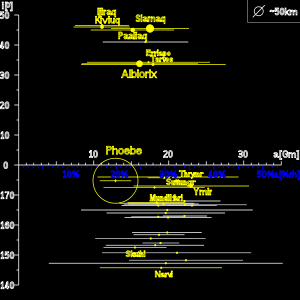
- Prograde satellites
- The Gallic group shares an average inclination of 34°. Their orbits are dynamically tight (δV ≈ 50 m/s), and they are light red in colour; the colouring is homogenous at both visible and near infra-red wavelengths.
- The Inuit group shares an average inclination of 46°. Their orbits are widely dispersed (δV ≈ 350 m/s) but they are physically homogenous, sharing a light red colouring.
- Retrograde satellites
- The Norse group is defined mostly for naming purposes; the orbital parameters are very widely dispersed. Sub-divisions have been investigated, including
- The PhoebePhoebe (moon)Phoebe is an irregular satellite of Saturn. It was discovered by William Henry Pickering on 17 March 1899 from photographic plates that had been taken starting on 16 August 1898 at the Boyden Observatory near Arequipa, Peru, by DeLisle Stewart...
group shares an average inclination of 174°; this sub-group too is widely dispersed, and may be further divided into at least two sub-sub-groups - The SkathiSkathi (moon)Skathi , or Saturn XXVII, is a natural satellite of Saturn. It was discovered by Brett Gladman, Kavelaars, et al. in 2000, and given the temporary designation S/2000 S 8....
group is a possible sub-group of the Norse group
- The Phoebe
- The Norse group is defined mostly for naming purposes; the orbital parameters are very widely dispersed. Sub-divisions have been investigated, including
Irregulars of Uranus and Neptune

| Planet | rmin |
|---|---|
| Jupiter | 1.5 km |
| Saturn | 3 km |
| Uranus | 7 km |
| Neptune | 16 km |
According to current knowledge, the number of irregular satellites orbiting Uranus and Neptune is smaller than that of Jupiter and Saturn. However, it is believed this is simply a result of observational difficulties due to the greater distance of Uranus and Neptune. The table at left shows the minimum radius
Radius
In classical geometry, a radius of a circle or sphere is any line segment from its center to its perimeter. By extension, the radius of a circle or sphere is the length of any such segment, which is half the diameter. If the object does not have an obvious center, the term may refer to its...
(rmin) of satellites that can be detected with current technology, assuming an albedo
Albedo
Albedo , or reflection coefficient, is the diffuse reflectivity or reflecting power of a surface. It is defined as the ratio of reflected radiation from the surface to incident radiation upon it...
of 0.04; thus, there are almost certainly small Uranian and Neptunian moons that cannot yet be seen.
Due to the smaller numbers, statistically significant conclusions about the groupings are difficult. A single origin for the retrograde irregulars of Uranus seems unlikely given a dispersion of the orbital parameters that would require high impulse (δV ≈ 300 km) implying a large diameter of the impactor (395 km), which is incompatible in turn with the size distribution of the fragments. Instead, the existence of two groupings has been speculated:
- CalibanCaliban (moon)Caliban is the second largest retrograde irregular moon of Uranus. It was discovered on 6 September 1997 by Brett J. Gladman, Philip D. Nicholson, Joseph A. Burns, and John J...
group - SycoraxSycorax (moon)Sycorax is the largest retrograde irregular satellite of Uranus. Sycorax was discovered on 6 September 1997 by Brett J. Gladman, Philip D. Nicholson, Joseph A. Burns, and John J...
group
These two groups are distinct (with 3σ confidence) in their distance from Uranus and in their eccentricity.
However, these groupings are not directly supported by the observed colours: Caliban and Sycorax appear light red while the smaller moons are grey.
For Neptune, a possible common origin of Psamathe
Psamathe (moon)
Psamathe , also known as Neptune X, is a retrograde irregular satellite of Neptune. It is named after Psamathe, one of the Nereids. This moon was discovered by Scott S. Sheppard and David C. Jewitt in 2003 using the 8.2 meter Subaru telescope...
and Neso has been noted. Given the similar (grey) colours, it was also suggested that Halimede could be a fragment of Nereid. The two satellites have had a very high probability (41%) of collision over the age of the solar system.
Exploration
To date, the only irregular satellite to have been visited by a spacecraft is PhoebePhoebe (moon)
Phoebe is an irregular satellite of Saturn. It was discovered by William Henry Pickering on 17 March 1899 from photographic plates that had been taken starting on 16 August 1898 at the Boyden Observatory near Arequipa, Peru, by DeLisle Stewart...
, the largest of Saturn's irregulars, which was photographed by the Cassini probe in 2005. Cassini also captured a distant, low resolution image of Jupiter's Himalia
Himalia (moon)
Himalia is the largest irregular satellite of Jupiter, the sixth largest overall in size, and the fifth largest in mass. It was discovered by Charles Dillon Perrine at the Lick Observatory on 3 December 1904 and is named after the nymph Himalia, who bore three sons of Zeus .- Discovery...
in 2000. There are no spacecraft planned to visit any irregular satellites in the future.
External links
- David Jewitt's pages
- Scott Sheppard's pages
- Discovery circumstances from JPL
- Mean orbital elements from JPL
- MPC: Natural Satellites Ephemeris Service

